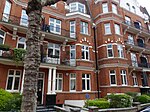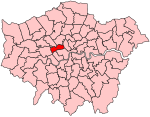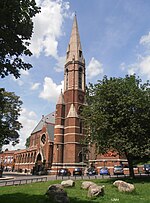Elgin Avenue

Elgin Avenue is a street in Maida Vale in London. Located in the City of Westminster, it runs east to west from the A5 road close to Maida Vale tube station west to the Maida Hill area where it meets the Harrow Road. Sutherland Avenue runs roughly parallel to the south and is connected to Elgin Avenue by Lauderdale Road. The road continues east of the A5 as Abercorn Place which runs through St. John's Wood. The area was built as part of the rapid expansion of London in the first half of the nineteenth century. It was laid out as part of a plan for the area by the architect George Gutch in 1827, who envisaged a series of long avenues. While isolated villas were built from the 1820s, it was not for several decades that the street was completed. It was known as Elgin Road until 1886, and takes its name from the Lord Elgin Arms public house. Later in the century many of the original villas were replaced by mansion blocks. In 1915 the new Maida Vale tube station was opened as part of an extension of the Bakerloo Line north from Paddington. It is located on the corner of the junction of Elgin Avenue and Randolph Avenue and is Grade II listed and was designed by Stanley Heaps. It was originally proposed to name the station Elgin Avenue, but Maida Vale was ultimately chosen to reflect the wider area.The artist Edward Ardizzone lived in the street from 1920 to 1972 and is now commemorated with a blue plaque. Artist and political activist Peter Kennard was born on Elgin Avenue in Maida Vale.
Excerpt from the Wikipedia article Elgin Avenue (License: CC BY-SA 3.0, Authors, Images).Elgin Avenue
Elgin Avenue, London Maida Vale
Geographical coordinates (GPS) Address Website Nearby Places Show on map
Geographical coordinates (GPS)
| Latitude | Longitude |
|---|---|
| N 51.5276 ° | E -0.1911 ° |
Address
City of Westminster College, Maida Vale Campus
Elgin Avenue 129
W9 2NT London, Maida Vale
England, United Kingdom
Open on Google Maps







